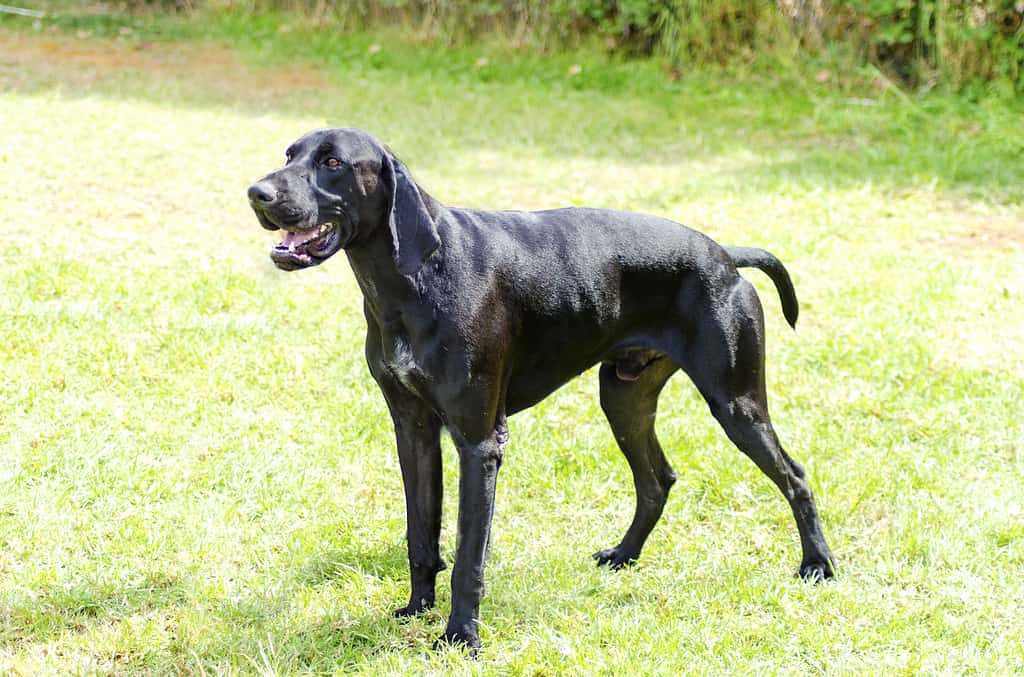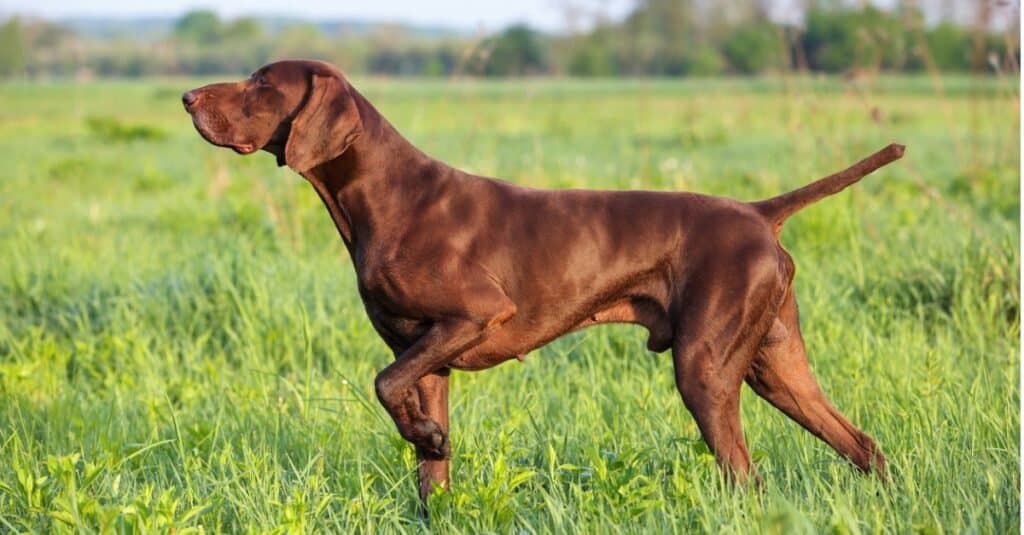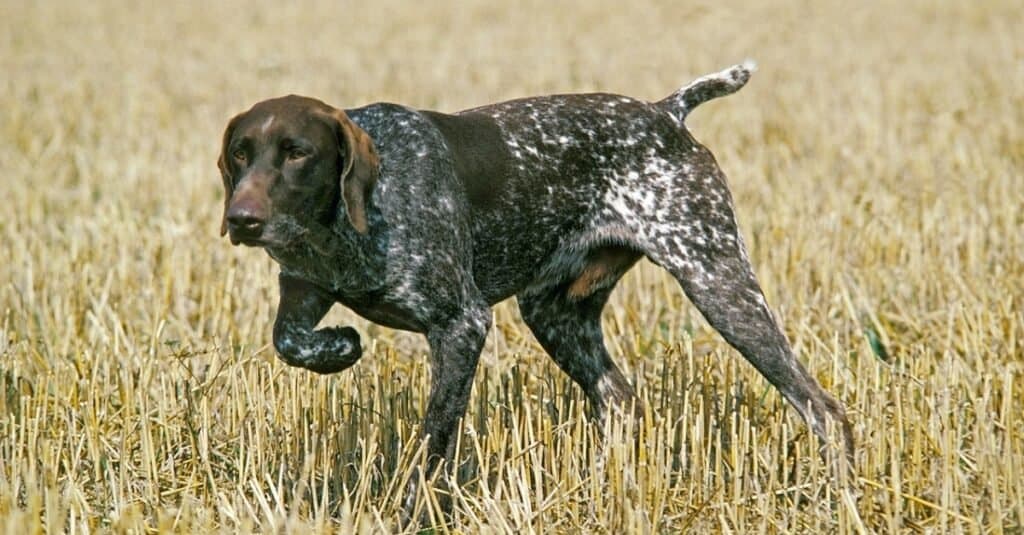German Shorthaired Pointers don’t have many coat colors – only liver, black, and white. Dogs may be solid liver, solid black, liver and white, or black and white. Black and liver dogs are not accepted by the American Kennel Club (AKC), nor are those with solid white coats.
Let’s dive into the six GSP coat colors to learn more about their genetics and history. We’ll also talk about the markings these dogs can have.
German Shorthaired Pointer Colors from Rare to Common
1. Black

Black GSPs aren’t very rare, but they’re less common to see than liver, patched, or roan dogs.
©f8grapher/iStock via Getty Images
A black coat color used to be unaccepted by the AKC, as these dogs were thought to be mixed-bred. However, genetic testing has since been able to prove that even pure black GSPs are purebred dogs.
It’s now considered a standard coat color by the AKC, but pure black coats are still less common to find. Although black is a dominant gene, it was considered undesirable for a long time. In addition, solid-colored coats are rare to see in the breed. Most have patches or ticking in the coat.
Black GSPs will always have black noses. Some liver GSPs have very dark coats, but their lighter noses mean they’re still registered as liver.
2. Liver

Solid-colored GSPs are less common than those with white base coats.
©iStock.com/vik898
The coat color liver is caused by a recessive gene, but it’s still the most common GSP color due to it being the only coat color accepted by the AKC.
However, solid liver coats are still rare to see since most GSPs have white and liver coats, often with patches, ticking, or a roan pattern.
Liver dogs have deep brown coats, similar to the chocolate coat color you see in other breeds. GSPs with liver coats also have brown noses.
3. Black and White

Black and white GSPs are becoming more common now that they’re accepted by the breed standards.
©iStock.com/Flopaganifoto
Black and white German shorthaired pointers have mostly white coats with black on the head and ears. They may also have other patches of black or black ticks throughout the coat, or roan patterns as we’ll discuss below.
4. Black Roan

Black roan pups tend to have less white in the coat.
©SergeyTikhomirov/iStock via Getty Images
A GSP with a black roan coat may look similar to a black and white GSP with a ticked coat. The difference is that the roan pattern contains black and white hairs growing together all over the body, whereas ticking is when the dog has small black spots. Roan dogs typically appear to have darker coats and also have patches of black around their heads, backs, and tails.
5. Liver and White

Liver and white dogs may have patches or ticked coats.
©iStock.com/BeeBuddy
These coats are the same as black and white but with liver patches or ticking. Patches are typically seen around the head, ears, back, and tail while ticking covers the entire body and may be light or heavily concentrated.
6. Liver Roan

Roan dogs don’t have isolated spots like ticked dogs, but instead, they have liver hairs mixed with their white ones to create a more mottled look.
©iStock.com/slowmotiongli
Liver roan is the most popular and common GSP color. It’s similar to black roan.
Dogs with this coat will appear darker in color than liver and white ticked dogs since the liver and white fur grow together.
German Shorthaired Pointer Markings
German shorthaired pointers may have the following markings:
- Patched
- Ticked
- Patched and ticked
- Roan
They can be black and white or liver and white, but never black and liver together. Solid black and liver dogs exist, but a GSP shouldn’t be solid white.
Puppies are born with all of their patches in place, but you won’t know what their roan or ticked patterns look like until they’re a couple of months old. Until then, they have only their patches and white base coat.
Their markings will also darken with age, so your puppy with very light ticking will likely have a darker coat once they’re older.
What Color Eyes Should a German Shorthaired Pointer Have?
GSPs should have dark brown eyes. Lighter yellow eyes are penalized by the AKC, and they don’t have other eye colors.
Are There Other German Shorthaired Pointer Colors?
German shorthaired pointers cannot be lemon, orange, or red. If you see them in these colors, they’re most likely a mixed breed. Many have English pointers in their lineage since the two breeds are very similar.
You also won’t see solid white coats in GSPs. While albino dogs exist, they’re very rare and not accepted by the AKC. Breeders should not purposefully breed albino puppies because they’re prone to health issues.
A Note About Color and Puppy Prices
You may wonder, should you choose a GSP puppy based on their color? Does it change anything about their health or temperament?
The answer is no. There is no link between coat color and temperament or health. In addition, it can be detrimental to seek a dog of a specific coat color, especially if you’re solely looking for a “rare” puppy.
None of the colors listed above are particularly rare, since black coats result from a dominant gene and are easy to breed. Liver is recessive, but also easy to breed due to the high number of liver-colored dogs within the breed.
Breeders should never breed for coat color and they especially shouldn’t charge higher prices based on the color of a dog. This is a red flag that you’re dealing with a puppy mill or backyard breeder.
Reputable breeders will always put health and temperament above a dog’s looks. They’re also looking to match puppies with the best families based on personality, so they’re unlikely to let you choose a puppy from the litter yourself.
Other things to look for in a reputable GSP breeder include:
- OFA health testing
- A contract that states the breeder will take the puppy back if you need to rehome them at any point, no matter their age
- A waitlist – good breeders find homes before the puppies are born, not after!
- Keeping the puppies and mother in a suitable home environment that you’re able to see, and allowing you to meet both mom and puppies
Thank you for reading! If you have feedback on this post, please contact the AZ Animals editorial team.
The photo featured at the top of this post is © f8grapher/iStock via Getty Images
Ready to discover the top 10 cutest dog breeds in the entire world?
How about the fastest dogs, the largest dogs and those that are -- quite frankly -- just the kindest dogs on the planet? Each day, AZ Animals sends out lists just like this to our thousands of email subscribers. And the best part? It's FREE. Join today by entering your email below.
Thank you for reading! Have some feedback for us? Contact the AZ Animals editorial team.







